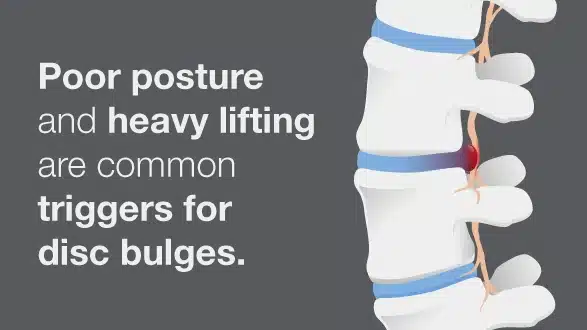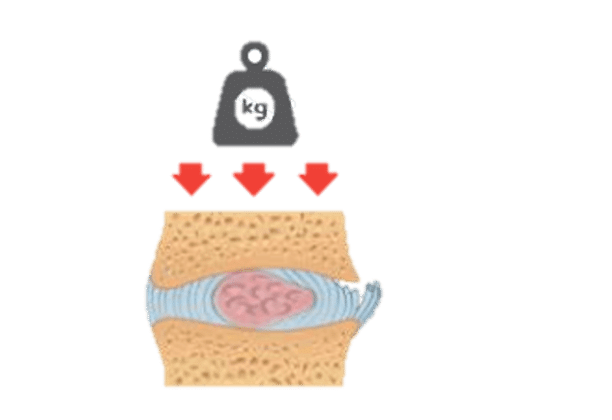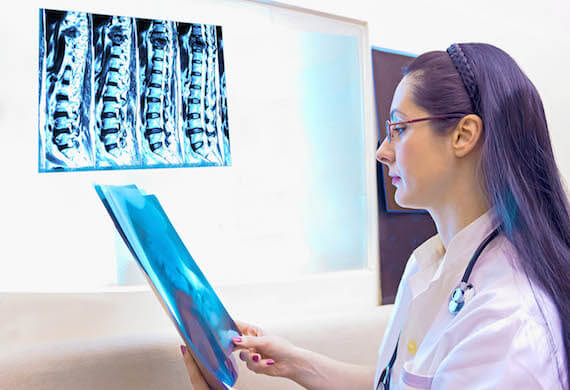Request Appointment
Enter your details and we will be in touch with you shortly;
Or call
8655885566
between 8 am and 8 pm.

Damage to the intervertebral (spinal) disc that causes it to bulge out of its alignment

The gel-like substance inside the vertebrae that absorbs any shock from impact loses its shape and position, leading to a disc bulge. Around 35% of back-pain patients suffer from disc bulge or disc degeneration, and most of them are affected in the lower back. Early detection and appropriate disc bulge therapy can significantly relieve symptoms while preventing the problem from degenerating. Read more about back and neck conditions among adolescents and young adults here.
A bulging disc might not cause any pain or give any symptoms as it may not have reached a certain severity level, and this might make it difficult to identify the condition before it shows any symptoms. However, when the disc gets pressed against a spinal nerve root, you may experience symptoms like pain, tingling, numbness, or muscle weakness. The symptoms of bulging discs vary according to the severity of the bulge and the affected level of your spine. Here are the symptoms that will help you to follow the suitable disc bulge relief treatment for you.
Get immediate medical care if:
If there’s sciatica or a pinched nerve in the spine, it will interfere with your daily functioning.
 Professional diagnosis required
Professional diagnosis required Chronic, can last for years
Chronic, can last for years Treatable with 4 weeks of QI Spine Therapy
Treatable with 4 weeks of QI Spine TherapyMany different factors cause disc bulge, but the most common conditions that lead to bulging discs are as follows:
Implementing posture correction for disc bulge relief and physical therapy for bulging discs into daily life is are helpful preventive measure. Early diagnosis and non-surgical disc bulge treatment will help you manage discomfort and return to your regular life.
An effective approach that involves a primary prevention plan that entails early identification and intervention is appropriate. Early intervention with proper disc bulge treatment and, when necessary, specific herniated discs treatment will help you with the progression.
Scoliosis and related disc disorders are medical conditions with possible fatal complications if not well handled. Key points include:
Conservative measures, such as disc bulge therapy, including methods like lumbar disc bulge therapy and spinal decompression for disc bulge, play a key role in preserving function and ensuring effective herniated disc management.
 Professional diagnosis required
Professional diagnosis required Chronic, can last for years
Chronic, can last for years Treatable with 4 weeks of QI Spine Therapy
Treatable with 4 weeks of QI Spine TherapyIf a disc bulge isn’t treated on time, it can lead to disc herniation (commonly known as a slipped disc). The disc bulge treatment is often based on the patient’s age and the severity of the condition:
This step is only taken if the pain cannot be managed in 6-8 weeks and the condition is intolerable for the patient. Most cases can be managed with conservative treatment methods only, and only about 5% of cases require surgery.
Diagnosing and treating bulging discs on time is essential. If a disc bulge is not treated on time, then it may lead to disc herniation. The treatment is often based on the age of the patient and the severity of the condition.
Bulging disc treatment mainly consists of spine rehabilitation by isolating the inefficient muscles of the spine. With the help of DSA, weaker muscles are identified, isolated, and treated. This approach not only reduces the pain but also strengthens the weaker muscles.
QI Spine also offers a cell repair technology for bulging disc treatment, wherein frequency specific microcurrents are administered to the patient. It reduces pain and inflammation, and also speeds up the healing process.
You can follow the tips below to prevent a bulging disc:
A bulging disc itself can lead to other complications; the most common one is spinal stenosis. Spinal stenosis happens when a bulging or herniated disc pinches the spinal cord, which can lead to temporary or permanent paralysis.
So, if you experience numbness in the groin area or your feet, or incontinence, then you must seek immediate medical help. If these symptoms are left ignored, it can lead to irreversible nerve damage.
Visit a doctor if your pain doesn’t improve with medications, neck or back pain is radiating down your arm/leg, or if you have numbness, tingling or weakness, or difficulty in controlling bowel/bladder movement.
Lifestyle changes are critical in the management of disc illnesses, and this involves acquiring good habits that conserve the spine. Consider the following strategies:
Incorporation of these self-care measures together with your personalized disc bulge relief therapy will help take care of the spine, maintain consistent relief, and reduce the chances of worsening of the disease.
 Professional diagnosis required
Professional diagnosis required Chronic, can last for years
Chronic, can last for years Treatable with 4 weeks of QI Spine Therapy
Treatable with 4 weeks of QI Spine TherapyIf disc bulge isn’t treated on time, it can lead to disc herniation (commonly known as slipped disc). The treatment is often based on the patient’s age and the severity of the condition:
 Professional diagnosis required
Professional diagnosis required Chronic, can last for years
Chronic, can last for years Treatable with 4 weeks of QI Spine Therapy
Treatable with 4 weeks of QI Spine TherapyThe bulging disc symptoms can mimic other conditions of the spine. Hence, obtaining an accurate diagnosis is important. Your physician will go through your medical history and check for your symptoms along with physical examination.
Your doctor may advise you to get a few tests, like:
Nerve conduction studies and electromyography are some of the most useful tests for identifying the location of the nerve injury and for managing the patients’ rehabilitation.
Nerve Conduction Study
Electromyogram (EMG)
The spine doctor will go through your previous medical records, conduct a physical examination and check for your symptoms. A neurological examination might be done to check your reflexes, muscle strength, ability to walk, and ability to feel.
If required, you may be asked to get a few imaging tests like X-ray, CT scan, and MRI scan to check which nerves have been affected. Digital Spine Analysis test analyzes the muscles around the spine, which might have gone into inefficiency, hence leading to a bulging disc. Here is how DSA is conducted & its benefits:
After the thorough analysis, the doctor will design a personalized disc bulge therapy for you. The therapy follows the whole patient's journey, and our spine doctors will guide you from the first day of consultation to post-care. You and the doctor can also track the treatment details over QI Spine’s app. The app also lets you map your exercise and treatment routine, schedule your video consultation or in-clinic appointment, and track your recovery progress.
 Professional diagnosis required
Professional diagnosis required Chronic, can last for years
Chronic, can last for years Treatable with 4 weeks of QI Spine Therapy
Treatable with 4 weeks of QI Spine Therapy






Have a question?
Ask our spine specialists
Who is a QI Spine Specialist?
A QI Spine Specialist is a medical expert with

Dr. Nidhi Sanghvi Shah

Dr. Shital Gaikwad

Dr. Richa Bhatia
9000 hours
of specialisation in treating back and neck conditions
32 hours
of spine physiotherapy specialisation methods in McKenzie concepts, Kinetic control, Neurodynamic solutions, Mulligan’s concepts
500 hours
and 6 months of QI Spine specialisation courses
A disc bulge can be treated with great success; however, a total reversal and remedy of the condition may have different outcomes for each individual. Non-surgical treatment for disc bulge, like physical therapy and lifestyle changes, often provides long-term relief.
An L4 or L5 disc should be treated with utmost concern because a disc bulge in these areas may affect the nerves. It may cause lower back pain, leg numbness, or weakness, requiring pain management for disc bulge and sometimes more advanced care.
Get into the side sleeping position with a pillow between the knees, or sleep on your back with an adequate small pillow under the knees. These positions reduce pressure on the spine and support spinal alignment for disc recovery.
Yes, most bulging discs heal without surgery through physical therapy for disc bulge, exercise, posture correction, and anti-inflammatory care. The surgery is performed only if a conservative approach does not work for several months or even a year.
Gentle exercises like pelvic tilts, knee-to-chest stretches, and McKenzie extension exercises for disc bulge help reduce pressure and strengthen the spine. However, it is advised that individuals always consult a physiotherapy guide to avoid further harm.
No, a bulging disc is not the same as a herniated disc.
When the disc sags and looks like it’s protruding outwards, but the outer covering of the disc remains intact, it is called a bulging disc. Whereas when the outer covering of the disc experiences a tear due to which the inner fluid oozes out into the spinal canal, it is called a herniated disc. A herniated disc is an increased level of severity of a disc bulge.
Generally, bulging discs are age-related degeneration. The discs deteriorate as we age and bulge downward. It develops over time. A bulging disc occurs when a disc suffers some damage and is pushed outward from its position extending beyond the vertebrae.
Basically, pain management and physical therapy are the two ideal non-surgical, non-invasive bulging disc treatment options.
Yes, it is true. A herniated disc may actually begin with a bulging disc whose outer wall has been ruptured.
You must visit a spine specialist if you start experiencing the following signs: